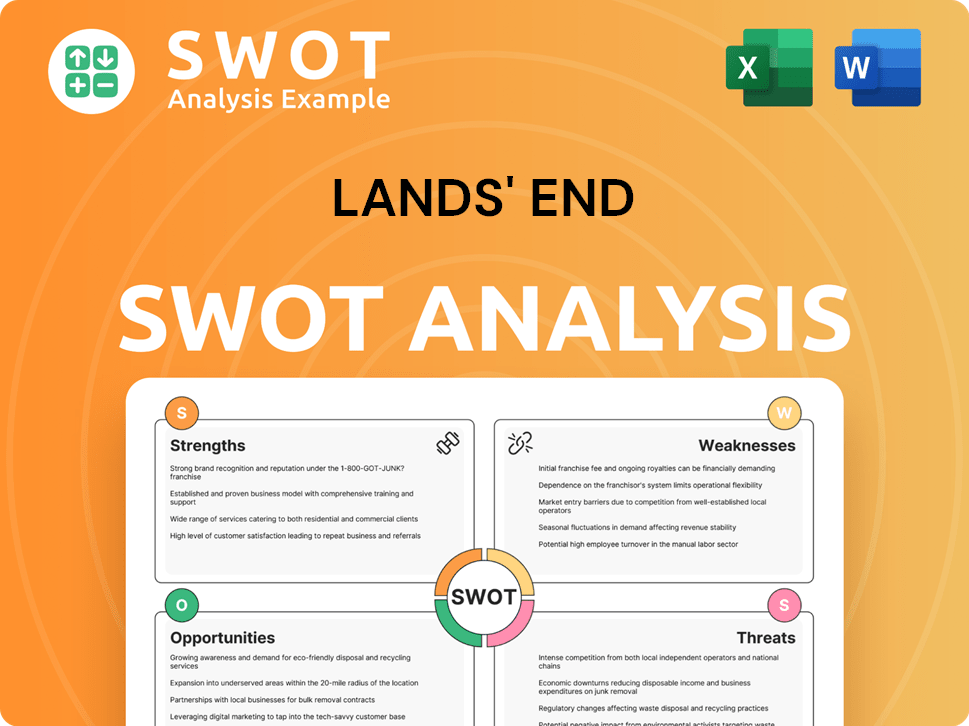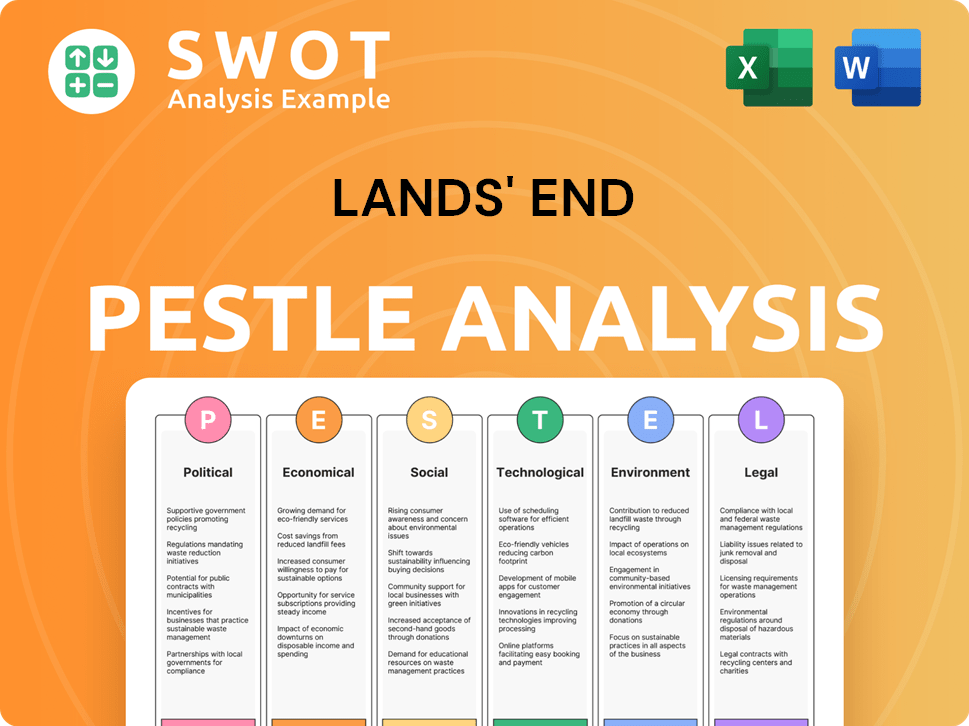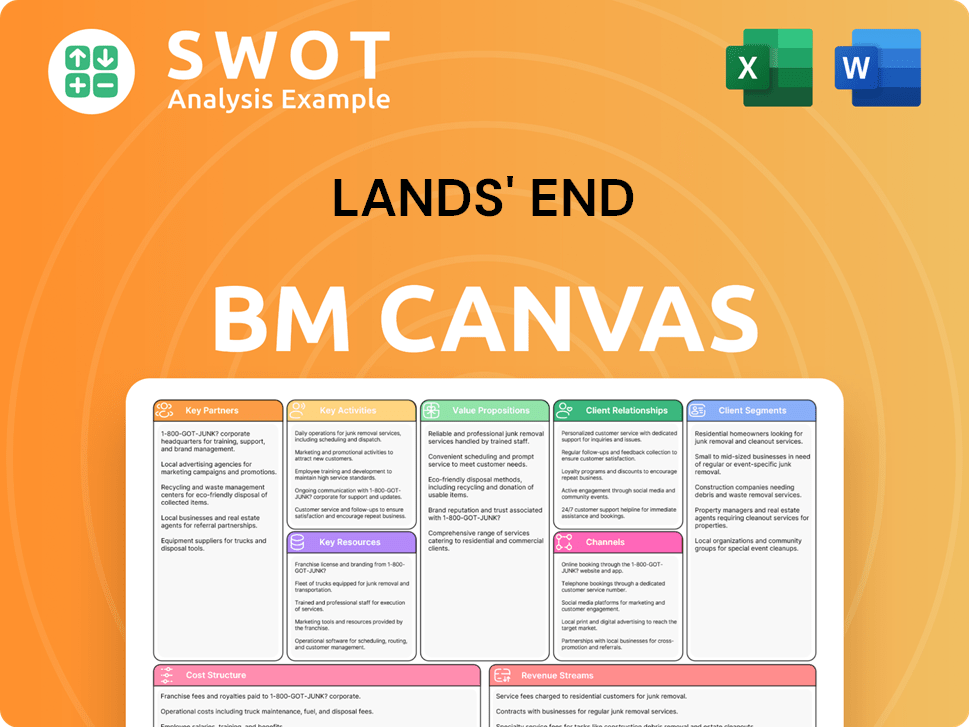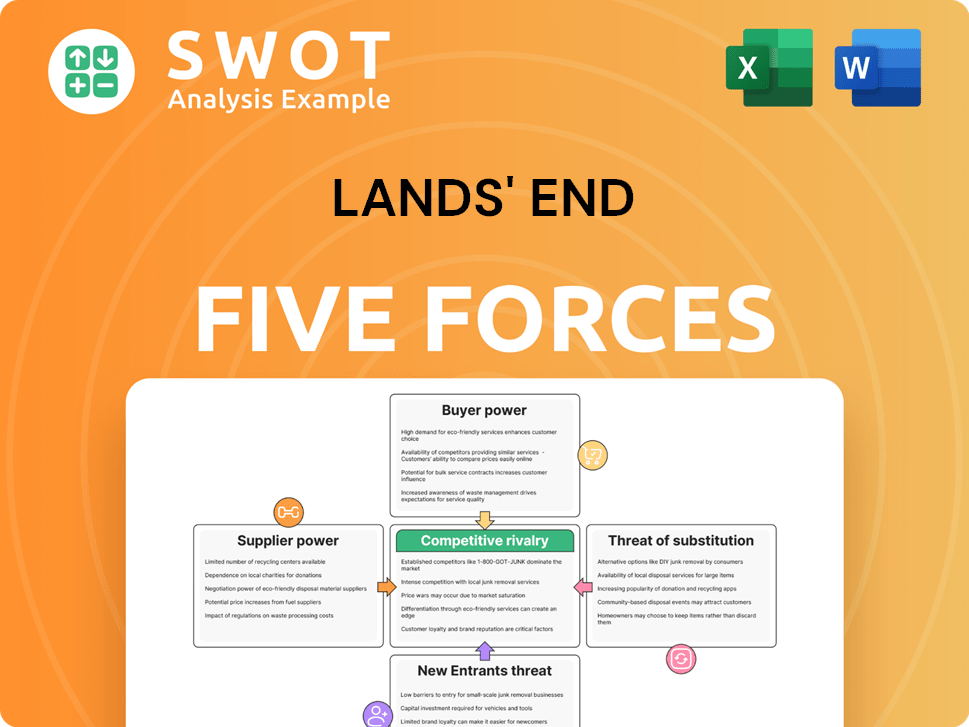Lands' End Bundle
Who Really Owns Lands' End?
Unraveling the Lands' End SWOT Analysis and understanding its ownership structure is key to grasping its strategic direction and market positioning. From its humble beginnings as a mail-order business to its current status as a multi-channel retailer, Lands' End's journey has been marked by significant ownership shifts. Discover the key players and pivotal moments that have shaped the company's destiny.

This exploration into Lands' End ownership will illuminate the evolution of the company, from its founding to its independence. We'll examine the influence of its Lands' End parent company and the impact of its spin-off from Sears Holdings. Understanding who owns Lands' End provides crucial insights into its financial health, strategic decisions, and future prospects, making this a vital analysis for investors and business strategists alike.
Who Founded Lands' End?
The story of Lands' End begins with Gary Comer, a Chicago copywriter and sailing enthusiast, who founded the company in 1963. Comer's initial vision was a mail-order business specializing in sailing equipment. He launched the venture with a modest investment, setting the stage for what would become a well-known brand.
Comer's early partners included Richard Stearns, a gold medalist sailor, and Robert Halperin, along with two employees of Stearns. The company's name, a result of a printing error, became a defining characteristic. This initial misstep, however, did not deter Comer; instead, it became part of the company's identity.
Comer's focus on quality and customer service was evident from the start. He addressed product issues transparently, which helped build customer loyalty. This approach, along with strategic expansions, set the foundation for Lands' End's growth and its eventual evolution into a broader apparel and retail brand.
Gary Comer founded Lands' End in 1963. He started the company with a $5,000 loan against his life insurance policy.
Comer partnered with Richard Stearns and Robert Halperin. Stearns was a 1963 Pan American Games gold medalist sailor.
The company's name was the result of a printing error. The apostrophe was misplaced in 'Land's End'.
Lands' End initially focused on sailing equipment. The company emphasized quality products and customer service.
Lands' End expanded into general clothing by 1973. The company relocated its headquarters to Dodgeville, Wisconsin, in 1978.
Lands' End became a public company in October 1986. The IPO marked a significant milestone in the company's history.
Understanding the evolution of Lands' End's history reveals its ownership structure. Initially a privately held company, Lands' End transitioned to public ownership through an IPO in 1986. The company's journey from a mail-order business to a publicly traded entity reflects its growth and strategic decisions over the years. The company's headquarters remain in Dodgeville, Wisconsin, a testament to its long-standing presence and commitment to its operational base.
Lands' End's journey includes pivotal moments that shaped its identity and market position.
- 1963: Gary Comer founds Lands' End as a mail-order business for sailing equipment.
- 1973: The company expands its product line to include general clothing.
- 1978: Lands' End relocates its headquarters to Dodgeville, Wisconsin.
- 1986: Lands' End becomes a public company through an initial public offering (IPO).
Lands' End SWOT Analysis
- Complete SWOT Breakdown
- Fully Customizable
- Editable in Excel & Word
- Professional Formatting
- Investor-Ready Format

How Has Lands' End’s Ownership Changed Over Time?
The journey of Lands' End ownership has seen significant shifts since its initial public offering in October 1986. A pivotal moment occurred in 2002 when Sears, Roebuck and Company acquired the company for $2 billion. This integration allowed Lands' End products to be sold in Sears stores, expanding its retail presence. However, the relationship evolved, leading to a spin-off in April 2014, making Lands' End an independent publicly traded company again. This move distributed shares to Sears Holdings' existing shareholders, fundamentally altering the ownership landscape.
As of May 2025, the ownership structure of Lands' End (NASDAQ: LE) is a mix of institutional investors, insiders, and public shareholders. Edward S. Lampert holds a significant stake, with 55.34% of the company's equities as of April 17, 2025, representing 17,116,376 shares. Sears Holdings Corp is also listed as a large individual shareholder, owning 31.96 million shares, representing 104.87% of the company as of 2025, which likely reflects the distribution from the spin-off or a holding entity.
| Stakeholder | Shares Held (as of April 17, 2025) | Percentage of Ownership |
|---|---|---|
| Edward S. Lampert | 17,116,376 | 55.34% |
| Capital Research Global Investors | 2,100,000 | 6.79% |
| BlackRock Inc. | 1,273,790 | 4.18% |
Institutional investors hold a substantial portion of Lands' End shares, with ownership at 31.89% in 2025. Key institutional shareholders include Capital Research Global Investors (6.79%), BlackRock Inc. (4.18%), Dimensional Fund Advisors LP (3.95%), and Vanguard Group Inc. (2.21%). These holdings can significantly influence company strategy and governance. To understand more about the company's financial performance, consider exploring the Revenue Streams & Business Model of Lands' End.
The ownership of Lands' End has evolved significantly, from its IPO to its acquisition by Sears and subsequent spin-off.
- Edward S. Lampert is a major individual shareholder, holding a significant percentage of the company's equities.
- Institutional investors collectively hold a substantial portion of the shares, influencing company decisions.
- The current ownership structure reflects a mix of institutional, insider, and public shareholders.
Lands' End PESTLE Analysis
- Covers All 6 PESTLE Categories
- No Research Needed – Save Hours of Work
- Built by Experts, Trusted by Consultants
- Instant Download, Ready to Use
- 100% Editable, Fully Customizable

Who Sits on Lands' End’s Board?
The Board of Directors at Lands' End guides the company's strategic direction, representing shareholder interests. Key members include Robert Galvin, Gordon Hartogensis, Elizabeth Leykum, Josephine Linden (Chair), John T. McClain, Andrew J. McLean (CEO), and Alicia Parker. Andrew McLean, who has been the CEO since January 2023, is also a board member.
The board's composition ensures diverse perspectives and expertise to oversee the company's operations. The board is responsible for making important decisions, such as the recent strategic review initiated at the request of a major shareholder, Edward S. Lampert.
| Director | Title | Since |
|---|---|---|
| Robert Galvin | Director | 2014 |
| Gordon Hartogensis | Director | 2014 |
| Elizabeth Leykum | Director | 2023 |
| Josephine Linden | Chair of the Board | 2014 |
| John T. McClain | Director | 2014 |
| Andrew J. McLean | CEO & Director | 2023 |
| Alicia Parker | Director | 2023 |
Voting power at Lands' End is primarily based on a one-share-one-vote system for common stock. Shareholders vote on key matters like director elections, executive compensation, and auditor appointments. At the May 21, 2025, Annual Meeting of Stockholders, shareholders voted on director nominees, executive compensation, and the appointment of Deloitte & Touche LLP as the independent registered public accounting firm for fiscal year 2025.
Edward S. Lampert's significant ownership stake of 55.34% as of April 2025, gives him substantial influence over the company. His request led to the exploration of strategic alternatives, including a potential sale or merger, to maximize shareholder value. The board has engaged financial and legal advisors for this review.
- The board's decisions are significantly influenced by major shareholders.
- Shareholders' votes determine key decisions.
- Strategic reviews can be initiated based on shareholder requests.
- The company is currently exploring strategic alternatives.
Lands' End Business Model Canvas
- Complete 9-Block Business Model Canvas
- Effortlessly Communicate Your Business Strategy
- Investor-Ready BMC Format
- 100% Editable and Customizable
- Clear and Structured Layout

What Recent Changes Have Shaped Lands' End’s Ownership Landscape?
In early 2025, the Board of Directors initiated a strategic review process, including a potential sale or merger, to enhance shareholder value. This decision followed a request from Edward S. Lampert, the majority shareholder, who held 55.34% of the company's equities as of March 7, 2025, citing market undervaluation. This move highlights significant shifts and potential changes in the company's ownership profile and strategic direction. The current owner of the company is Edward S. Lampert.
The company has also been actively managing its financial position through share buybacks. A new repurchase program for up to $25 million of common stock was authorized in March 2024, set to expire in March 2026. For fiscal year 2024, the company repurchased nearly $13 million worth of its shares, with $13.5 million remaining in the program as of January 2025. These actions reflect the company's efforts to manage its capital structure and potentially influence its stock valuation. Understanding the Brief History of Lands' End provides a broader context for these recent developments.
| Metric | Details | As of |
|---|---|---|
| Institutional Ownership | 37.5% | Early June 2025 |
| Market Capitalization | $263 million | Early June 2025 |
| Insider Holdings | Increased to 1.09% | May 2025 |
| Institutional Holdings | Remained at 32.01% | May 2025 |
| Mutual Funds Holdings | Remained at 25.83% | May 2025 |
Financially, the company reported a net income of $6.2 million, or $0.20 per diluted share, for fiscal year 2024, a significant improvement from a loss in the previous year. However, for the first quarter of fiscal 2025, the company reported a net loss of $8.3 million on net revenue of $261.2 million, an 8.5% decrease. The company projects net revenue for fiscal 2025 to be between $1.33 billion and $1.45 billion, with adjusted EBITDA between $95.0 million and $107.0 million. These figures provide insight into the company's performance and future expectations.
Edward S. Lampert's significant ownership stake and the board's strategic review process indicate potential shifts in control. Institutional investors have shown mixed confidence, with some increasing and others decreasing their holdings.
Fiscal year 2024 showed a net income, but the first quarter of fiscal 2025 reported a net loss. The company is managing its capital through share repurchases.
The company forecasts net revenue for fiscal 2025 to be between $1.33 billion and $1.45 billion, with adjusted EBITDA projected between $95.0 million and $107.0 million.
The exploration of strategic alternatives, including a potential sale or merger, suggests a focus on maximizing shareholder value and adapting to market conditions.
Lands' End Porter's Five Forces Analysis
- Covers All 5 Competitive Forces in Detail
- Structured for Consultants, Students, and Founders
- 100% Editable in Microsoft Word & Excel
- Instant Digital Download – Use Immediately
- Compatible with Mac & PC – Fully Unlocked

Related Blogs
- What are Mission Vision & Core Values of Lands' End Company?
- What is Competitive Landscape of Lands' End Company?
- What is Growth Strategy and Future Prospects of Lands' End Company?
- How Does Lands' End Company Work?
- What is Sales and Marketing Strategy of Lands' End Company?
- What is Brief History of Lands' End Company?
- What is Customer Demographics and Target Market of Lands' End Company?
Disclaimer
All information, articles, and product details provided on this website are for general informational and educational purposes only. We do not claim any ownership over, nor do we intend to infringe upon, any trademarks, copyrights, logos, brand names, or other intellectual property mentioned or depicted on this site. Such intellectual property remains the property of its respective owners, and any references here are made solely for identification or informational purposes, without implying any affiliation, endorsement, or partnership.
We make no representations or warranties, express or implied, regarding the accuracy, completeness, or suitability of any content or products presented. Nothing on this website should be construed as legal, tax, investment, financial, medical, or other professional advice. In addition, no part of this site—including articles or product references—constitutes a solicitation, recommendation, endorsement, advertisement, or offer to buy or sell any securities, franchises, or other financial instruments, particularly in jurisdictions where such activity would be unlawful.
All content is of a general nature and may not address the specific circumstances of any individual or entity. It is not a substitute for professional advice or services. Any actions you take based on the information provided here are strictly at your own risk. You accept full responsibility for any decisions or outcomes arising from your use of this website and agree to release us from any liability in connection with your use of, or reliance upon, the content or products found herein.